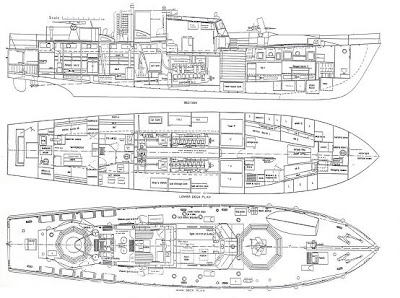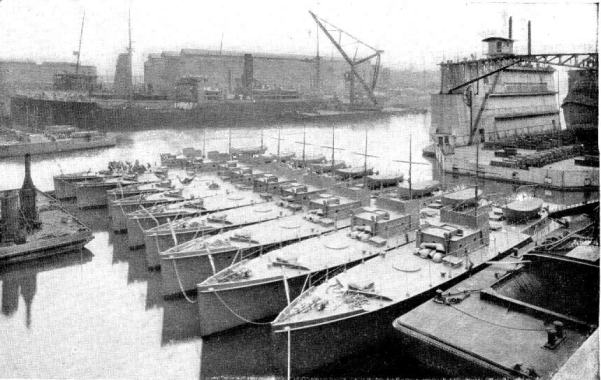Here's a little British number I hope you'll just love...

The Harbour Defence Motor Launch. This ubiquitous little stinging vessel will do wonders to flesh out those tiny harbours , ports and inland waterways ( Vietnam River Patrol Boat substitute ?).




Built to the tune of 486, it is quite concievable that this little blighter could show up anywhere.
Armed with only 20mms and MGs, she will not be a war winner, but just might be a thorn in the side of that shipping attack , bridge buster, E boat attack or submarine attack.


The Harbour Defence Motor Launch (HDML) was a British small motor vessel of the Second World War.
The HDML was designed by W J Holt at the Admiralty in early 1939. During World War II 486 HDMLs were
constructed, mainly by yacht builders, in the United Kingdom and a number of other allied countries. In
view of their later expanded combat roles in some Commonwealth navies some HDMLs were re-designated as Seaward Defence Motor Launches (SDML) or Seaward Defence Boats (SDB).
HDMLs had a round bilge heavy displacement hull 72 feet (22 m) long with a beam of 16 feet (4.9 m) and a loaded draught of 5 feet (1.5 m). Loaded displacement was 54 tons. The hull had a pronounced flare forward to throw the bow wave clear and provided considerable lift to prevent all but the heaviest seas from coming aboard. Although seaworthy, the boat had a considerable tendency to roll, especially when taking seas at anything other than directly ahead or astern. The cause was the round bilge midship section and a considerable reserve of stability, the effect of which was to impart a powerful righting moment if the boat was pushed over in a seaway. This, coupled with the round bilged hull and lack of bilge keels, would set up a rapid and violent rolling.
One of the design criteria was that the boat had to be capable of turning inside the turning circle of a
submerged submarine. To achieve this, HDMLs were fitted with two very large rudders and, to reduce
resistance (to turning), the keel ended 13 feet before the stern. A side effect of this was that the
boat lacked directional stability and was extremely difficult to hold on a straight course.
The hull was of round bilge wooden construction, planked with two diagonally opposed skins with a layer
of oiled calico between them – known as a “double-diagonal” technique. The hull was completed with
frames or “timbers” riveted perpendicularly from the keel to the gunwale on the inside of the planking,
forming a very strong hull. The hull was further strengthened by the addition of longitudinal stringers
riveted inside the timbers together with further timbers, known as "web frames". They are fastened
inside the stringers opposite every third main timber. HDMLs were fitted with a deeper section rubbing
strake aft. Its purpose was to roll depth charges (kept in and delivered from racks on the side decks),
clear of the hull and propellers.
Most HDML hulls were planked in mahogany, but as the war progressed this became scarce, larch was used although this tended to lead to leaky hulls. The decks were also of double-diagonal construction and generally made of softwood. Boats operating in tropical waters (including the Mediterranean) were
sheathed in copper below the waterline to prevent the attack of marine borers.
In order to lessen the chances of the boat sinking in the event of damage to the hull, they were divided
into six watertight compartments. Provided that the bulkheads were not damaged, the boat could remain afloat with any one compartment flooded.
The HDMLs had a manned engine room which usually comprised two engine room staff when in Royal Naval service. There was no direct bridge control of the prime movers (main engines) or machinery. A small ship's telegraph system was used in conjunction with a buzzer system, with predetermined signals for the communication of orders between the engineer and master.
The engineer operated the machinery from a position between the main engine propulsion gearboxes on the centreline of the vessel. This was generally done in the sitting down position, using a removable seat which was hung from the engine room access ladder. Four levers were used to control the two engine's rpm settings and the direction of drive to the propellers via reversing gearboxes. A governor (speed control) control lever was used to adjust the engine rpm, and a gearbox lever was used with positions for ahead, neutral and reverse.
Settings for the engine governor controls (HDMLs fitted with Gardner 8L3s) were SLOW 250 rpm, HALF 600 rpm, FULL 800rpm and EMERGENCY FULL 900 rpm, and those settings were possible with the gearboxes in ahead or astern. The vessel's telegraphs indicated the required settings for all levers at any one time.
Other operations included the monitoring of the water jacket temperatures of both prime movers. Gardner design engineers designed the early marine variants of the 8L3s to be direct salt water cooled, with an allowance for corrosion included in the water jacket wall thickness. To maintain the correct operating temperature of 62 degrees C, a bypass valve was incorporated in the cooling circuit. This allowed varying amounts of the coolant to be diverted back to the feed side of the pump, thus raising the water temperature before circulating it around the engine. This in turn resulted in a higher overall engine temperature.
A third engine was installed within the machinery space to provide motive power for electrical
generation and to operate the fire and bilge pump set. This was also a Gardner sourced engine of the
type 1L2, and was a single cylinder hand start unit producing 7.5hp.
Other features of the machinery space were five liquid storage tanks. Two large fuel oil tanks on the
centre of each wing, with two day service fuel oil tanks just forward of the former, which supplied fuel
to all engines by gravity feed. The fifth tank was used to store lubrication oil, and this was generally
sited on the Port side aft area of the space. The adjacent space on the STB side provided space for the
engineer's work bench.
Armament
Initially HDMLs were commonly fitted with a QF 2-pounder gun on the foredeck, an Oerlikon 20 mm High
Angle/Low Angle cannon on the stern cabin (this could also be used for anti-aircraft defence) and a
0.303 Vickers machine gun on each side of the bridge. They carried 6 to 8 depth charges, on the aft
decks. The 2-pounder guns were not particularly accurate, possibly because of the boats' tendency to
roll, and many were replaced by another Oerlikon HA/LA gun.
HDMLs were originally intended for the defence of estuarial and local waters, they proved such a
seaworthy and versatile design that they were used in every theatre of operations as the war progressed. They were to be found escorting convoys off the West Coast of Africa, carrying out covert activities in the Mediterranean and undertaking anti-submarine patrols off Iceland.
HDMLs were initially transported as deck cargo on larger ships for foreign service, which is why their
length was restricted to 72 feet. Later in the war, with many merchant ships being sunk, it was found to
be much safer to move them abroad under their own power. Some HDMLs (including 1301), undertook fairly substantial ocean voyages. Many belonging to the Mediterranean fleet sailed from the UK to Malta via Gibraltar in convoy, voyages which necessitated going well out into the Atlantic in order to keep clear of the enemy occupied coast. Three HDMLs were fitted with a second mast and sails with the intention of sailing to the Caribbean. In the event, they did not make this voyage, joining the Mediterranean fleet instead.
HDMLs were normally manned by Royal Naval Volunteer Reserve (RNVR) officers with temporary commissions, and “hostilities only” ratings. The crews, however, gained an enviable reputation for their skill and expertise in the handling and fighting of their vessels.
Specifications
Name: Harbour Defence Motor Launch (HDML)
Completed: 486
Active: The last HDMLs left Royal Naval service in the late 60s HDML 1387 is active and operates
from Haslar Marina, Gosport, England (20.02.2011)
General characteristics
Displacement: 54 tons (Full load displacement)
Length: 72 ft (22 m)
Beam: 16 ft (4.9 m)
Draught: 5 ft (1.5 m)
Propulsion: Twin handed Gardner 8L3 marine engines, each 152 bhp @900rpm (113 KW), torque 892 lb.ft,
swept volume1473 cu.ins (24 litres), weight 3.5 tons, bore 51/2 in. (139.7mm), stroke 73/4 in.
(196.8mm)[1]
Speed: 12.5 knots
Range: 2,000 miles at 10 kts (1,650 gallons)
Complement: two officers, two petty officers and eight ratings
Armament: typically twin 20mm Oerlikons, twin Vickers K machine guns and six depth charges
Commando Landings!!!

Under Construction

In glorious colour - note this model is a late variant, with the 2 Pounder MA replaced by an additional 20mm Oerlikon

Maybe they aren't everywhere...but they should be.

Kopfdorfer
 Author
Topic: HDML or Harbour Defence Motor Launch (Read 15721 times)
Author
Topic: HDML or Harbour Defence Motor Launch (Read 15721 times)


